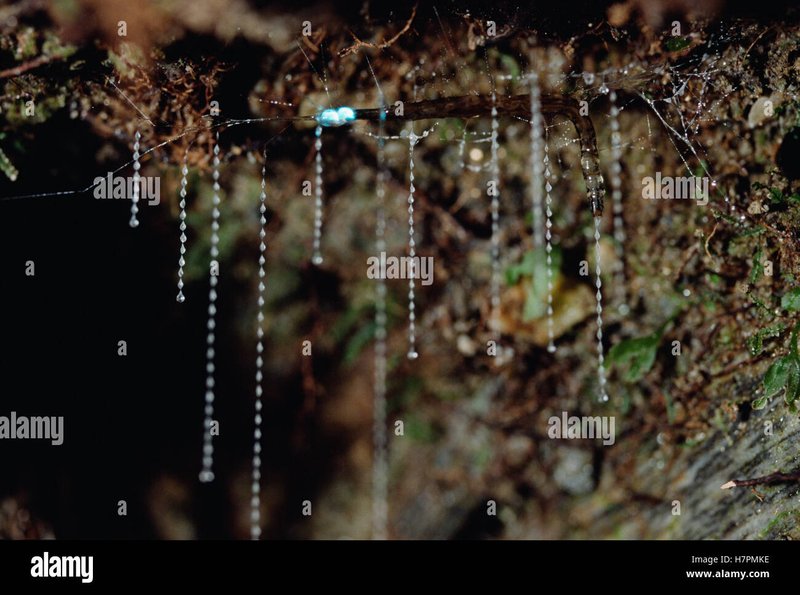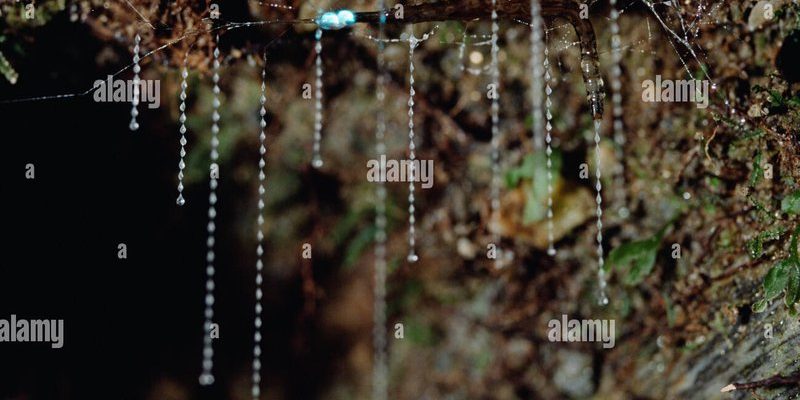
When we dive into the world of *Arachnocampa luminosa*, we’re not just looking at their stunning appearance; we’re also exploring their unique life cycle, habitat, and the roles they play in our ecosystems. So grab a cup of coffee, and let’s take a journey into the enchanting life of these glow worms. You might just find yourself captivated by their story!
What Are Glow Worms?
When you hear the term “glow worm,” it might conjure up images of tiny insects glowing in the night. In reality, glow worms are not worms at all! Instead, they are the larvae of certain species of flies, particularly in the group known as *Lampyridae*. *Arachnocampa luminosa* is a prime example. These larvae have a unique ability to produce light, which they use for hunting and attracting mates.
Glow worms, specifically *Arachnocampa luminosa*, emit a bluish-green light thanks to a chemical reaction involving luciferin and oxygen. This process is akin to nature’s own light bulb, providing them with an efficient way to lure unsuspecting prey, like small insects, into their sticky silk traps. Imagine walking through a dark cave, and spotting these glowing lights—it feels like stumbling upon stars!
The Life Cycle of Arachnocampa Luminosa
The life cycle of *Arachnocampa luminosa* is quite interesting. It starts when the female lays her eggs in damp, secluded areas, often in caves or dark, humid spots. Once the eggs hatch, the larvae emerge, ready to start their glowing life.
These larvae are hungry little guys. They create silk threads that hang down from their bodies, forming a net-like structure in the dark. When an unsuspecting insect flies into this trap, they get stuck, allowing the glow worm to feast. This method of hunting is not just effective; it’s also a spectacular sight to behold!
As the larvae grow, they go through several molts before entering the pupal stage. This stage is where the magic happens—they transform into adult flies. Adults don’t glow and, interestingly, have a very short lifespan, often just a few days. Here’s a fun fact: they don’t even eat during this stage!
Where Can You Find Arachnocampa Luminosa?
If you’re eager to see *Arachnocampa luminosa* in action, you’ll want to head to New Zealand or parts of Australia, where they thrive in the wild. These glow worms are commonly found in limestone caves, where the damp, dark environment is perfect for their survival. Some popular sites include the Waitomo Caves in New Zealand, which attracts tourists wanting to witness the glow worm phenomenon.
The habitat is crucial for their life cycle. The larvae require high humidity and a stable temperature to develop. This makes caves an ideal home, as they provide protection from predators and an environment rich in moisture. It’s essential to preserve these habitats to ensure that these amazing creatures continue to thrive.
How Do Arachnocampa Luminosa Glow?
You might be wondering what causes these little larvae to glow in the first place. The secret lies in a biochemical reaction that takes place inside their bodies. When the enzyme luciferase reacts with the substrate luciferin in the presence of oxygen, light is produced. This process is similar to how fireflies light up at night!
The glow serves two primary purposes: attracting prey and deterring predators. The bluish-green light can lure insects closer, making it easier for the glow worm to catch its meal. At the same time, the light can also serve as a warning signal. Predators that are aware of how glow worms hunt may choose to steer clear due to the sticky silk traps that await.
This fascinating adaptation shows how nature has equipped *Arachnocampa luminosa* to survive in its specific niche. It’s like a built-in survival tool that works efficiently in the dark.
Conservation and the Future of Arachnocampa Luminosa
Sadly, the natural habitats of *Arachnocampa luminosa* face numerous threats, from habitat destruction to pollution. Preserving the caves and regions where these glow worms live is vital for their survival. Organizations and local governments work together to protect these ecosystems, ensuring that future generations can witness the awe of these glowing creatures.
Another aspect of conservation is educating the public about the importance of glow worms and their habitats. Many tour companies in areas like New Zealand focus on responsible tourism, promoting awareness and appreciation for these unique organisms. By visiting caves and respecting the environment, we can all contribute to protecting them.
Let’s not forget that every bit of effort counts. When we learn about and appreciate the wonders of nature, we take a step toward making a positive impact.
Fun Facts About Arachnocampa Luminosa
To wrap up our journey, here are some fun facts about *Arachnocampa luminosa* that you might not know:
- Size Matters: These larvae only grow to about an inch long, yet have a big impact on their environment.
- Not Just for Looks: The glow is not just for show—it’s mainly a hunting strategy to catch food.
- Short Lives: Adult glow worms live just long enough to mate—talk about a race against time!
- Tourist Attraction: The glow worm caves in New Zealand are a major tourist destination, attracting thousands each year.
- Ancient Organisms: Glow worms have been around for millions of years, showcasing their adaptability over time.
In conclusion, *Arachnocampa luminosa* is much more than just a pretty light in the dark. These glow worms are vital players in their ecosystems, showcasing the beauty and complexity of nature. I hope you feel a bit more connected to these glowing wonders and are inspired to learn more about the incredible world around us! Whether you find them in a cave or learn about them from afar, they remind us of nature’s magic and the importance of conservation.

